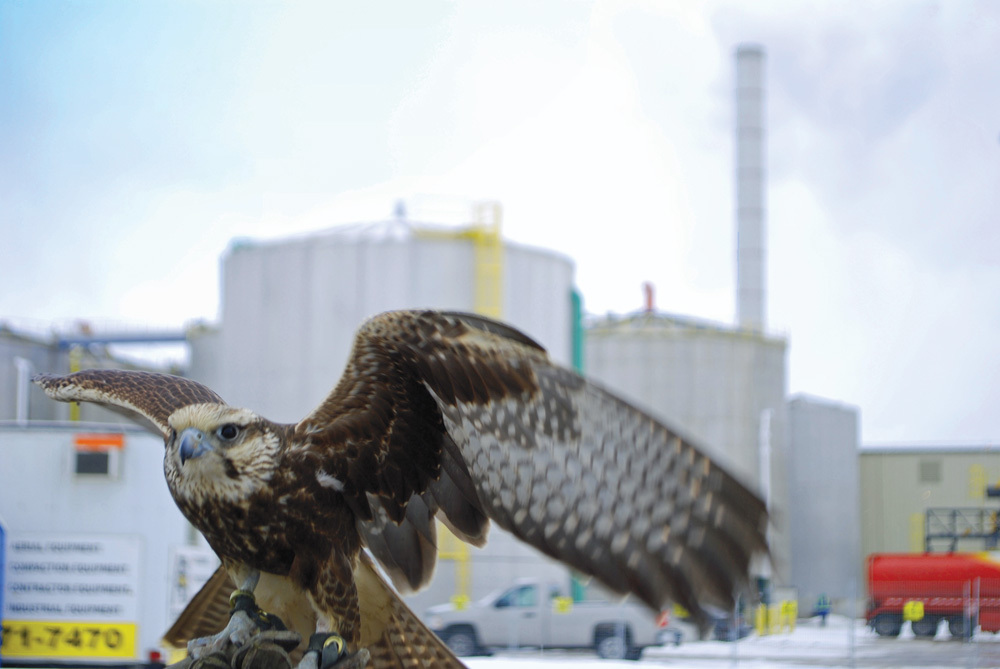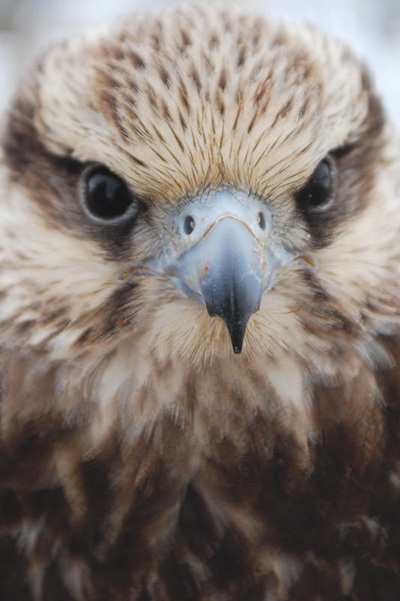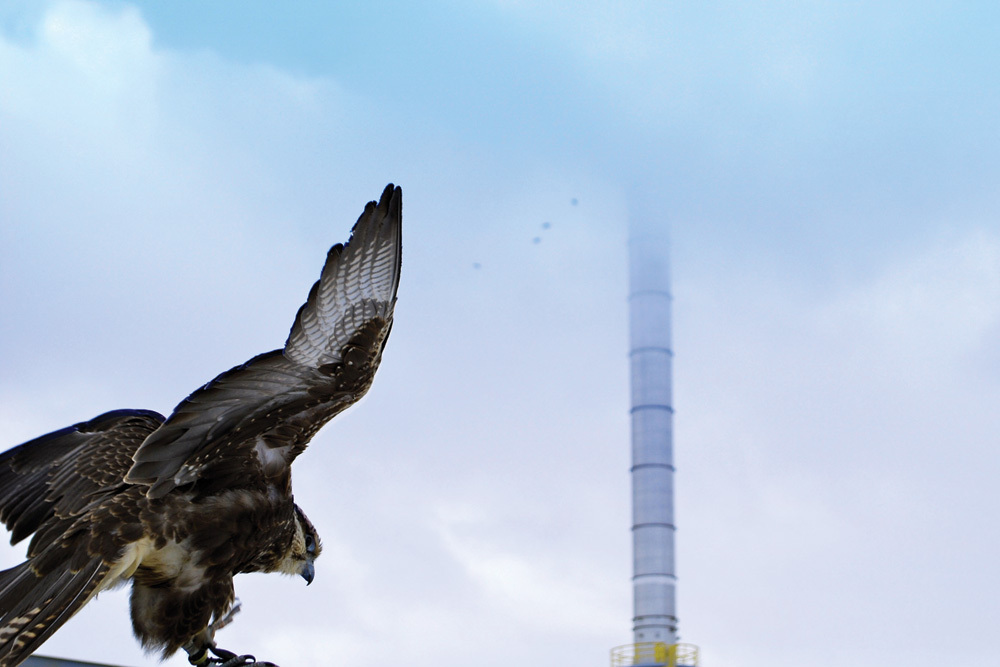Ancient Art of Falconry an Asset in Avian Pest Control




January 14, 2011
BY Stephen Bucciarelli & Melanie Paterack
An ethanol plant is a bird haven—a warm steel forest with an all day buffet. Such a readily available, continuous supply of food with numerous places for refuge and shelter, areas that generate warmth and various levels of peaks and towers create perfect wild bird habitat. The structures and environment of ethanol production provide ideal circumstances to sustain bird populations, especially over the winter months. Plant sites in the midst of corn communities not only aid in corn accessibility, but also tend to be places where birds naturally thrive. Typical species observed frequenting ethanol plants in large numbers are European starlings, house sparrows and pigeons.
When large numbers of these birds accumulate, they potentially pose health and safety issues, impact productivity, create fire hazards and cause product losses. While total prevention of birds on site is difficult, managing their numbers is a very realistic prospect.
Typical areas that attract nearby birds include towers, peaks and prominent, high points of the facility. Birds perched on these high spots serve as confidence birds. If a pigeon is perched on a tower, for example, it is serving as a sentry for any approaching dangers such as birds of prey. As long as these confidence birds remain in place, it signals to all surrounding birds that the area is safe and they can forage for food on the ground without consequence, where traditionally they would be vulnerable and exposed to predation. By managing the confidence birds, populations at lower levels are also controlled. Birds feeding without a lookout system in place will very quickly feel vulnerable, thus altering their psychology and instilling a level of fear. This can be achieved in an optimally timed effort with the use of falconry—the art of using trained birds of prey.
The corn-receiving area is usually the largest food source for resident birds, and unfortunately the easiest place for disease pathogens to enter a production system. The ceiling in these buildings usually gets torn to shreds by house sparrows which are gathering materials and building nests. Often these birds will pull out insulation, and then proceed to build nests in warm areas such as above lights and electrical wires. Apart from this obvious fire hazard from dry, flammable material being packed around ignition sources, wherever birds roost is where they eliminate waste in the highest concentration. Avian feces are extremely corrosive, having ammonia as its highest occurring inorganic nitrogen compound, which eats away at the protective sheath around wires, exacerbating the potential risk for fire and contamination.
Advertisement
Advertisement
Ethanol plants provide numerous other sites for flocks to colonize, as they will be attracted to any area that provides a food source, warmth or shelter. It is imperative to note that every plant is different and therefore will present unique challenges in bird control. Distinctive layouts, age and type of machinery at each facility create different levels of heat and noise. One facility may be overrun with wild quarry while another nearby location may not have as much as a feather on site.
Management Techniques
Evaluating the level of needed concern can be done inexpensively through pathogen testing, available from many universities, colleges and pest control companies. Areas where pathogens are occurring in the highest concentrations indicate problematic sites to be targeted. Swabs from such areas can be submitted to see if threats to human health exist. Recovered pathogens, which in some instances could warrant eradication, may include West Nile virus, avian influenza, histoplasmosis, Salmonella and E.coli.
Once problem locales have been determined, the next step is to consider bird psyche. Flight paths and movement need to be closely monitored. Once established, it may be possible to physically control access to the most appealing and frequented regions.
Methods include:
• Mist netting—the use of fine mesh nets as catch-barriers that can catch thousands of pest birds and keep them out of specific areas, serving as an economic, effective means of management.
• Falconry—the use of trained raptors (hawks, falcons, eagles) is extremely effective at pushing birds around a facility for ease of trapping, or scaring them away entirely; it makes birds uncomfortable and susceptible to predation. Falconry is an ideal control method prior to audits, for short-term image, or when wild birds could delay construction or work crews. Having raptors on site will clear birds from the available food source, eliminate confidence birds, and make roosting pest birds too uncomfortable to stay.
• Trapping can be used to relocate avian residents. For this technique to be effective, however, extraneous food sources must be controlled, such as spilled corn, in order to lure birds into baited traps. Of vital importance is that traps are equipped with adequate food and water, protection from the elements (insulation in winter, shade in summer), are free from predation, and are maintained and emptied routinely and frequently—ensuring the health and well-being of caught birds. If trapped birds are perishing in on-site traps, the company can be held criminally accountable for animal cruelty.
Advertisement
Advertisement
It is highly unadvised to utilize poisons to rid a facility of nuisance birds. Use of poisons is banned in Canada and many parts of the United States. Not only is it damaging to the environment and a company’s public image, it also counteracts any natural bird control. If there is a raptor naturally occurring in the vicinity, it is an active part of bird maintenance. Once a pest bird is poisoned, it appears drunk and is immediately picked out for predation if exposed. The toxin works its way up the food chain upon consumption and concentrates at the highest levels, as we saw in the DDT scare 40 years ago that almost annihilated bald eagle populations in North America. Wild raptors are assets, and a proper program capitalizes on them.
Successful avian deterrent and management can be achieved by combining some or all of these methods into a maintenance program that fluctuates seasonally. In addition, flexibility and openness to new ideas and approaches are important. The most unorthodox methodology may prove to be the most effective on an individual site. One solution may not fix all problems, however. Through careful delineation and some trial and error, a program can be tailored to meet the needs of each facility encompassing the most effective techniques. Each approach should be given a sufficient trial period, making adjustments as needed.
As a wildlife management company, we at Predator Bird Services Inc. employ numerous maintenance techniques with an emphasis on natural, eco-friendly approaches, continually seeking innovative ideas. Currently, we have installed a peregrine falcon nesting box, under the guidance and approval of a local natural resources management agency, to encourage a local breeding pair of falcons to take up residence at an industrial site. If successful, the peregrine falcons would become an integral component to the facility’s bird maintenance program, utilizing nature to its fullest. This would not only aid in sustaining this protected species, it would be an extremely cost-effective, atypical management tool.
Contracting Services
Successful management of avian infestations at an ethanol plant can become quite complicated due to the sheer number and variety of species, each with its own attraction to the site. While exact guarantees are impossible to make, changes to programs can be quickly made to increase efficacy.
When contracting services, look for a management company that will provide a comprehensive and thorough plan that includes multiple control strategies such as netting, falconry, trapping and pyrotechnics. Avoid companies that claim one method is the end-all, be-all to bird control. Be sure to contract someone with the integrity to duly conduct animal work. Keep in mind that compliance to a continued maintenance program may prove beneficial, as the availability of food and shelter for wild birds are inherent with ethanol production. That said, through systematic elimination of pest bird hotspots, plants could drastically reduce, if not eliminate, the concerns to health and safety and revenue losses posed by avian infestations.
Authors: Stephen Bucciarelli, president
Melanie Paterack, R&D, health and safety
Predator Bird Services Inc.
(519) 858-2555
info@predatorbirdservices.com
Upcoming Events





